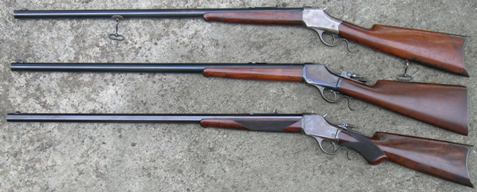April 15, 2005
 Offline
Offlinesteve004 said
Very nice and desirable rifle for sure. A question – the proof mark (front ring of the receiver) – what has happened there? Is that something Winchester did?
Steve,
That is very common. When the proof mark was struck, it popped all the bluing off of the steel. This gun was made during the “Flaking” era. It is surprising to see one made in that era that does not look like it has lost much of its bluing.
Bert
WACA Historian & Board of Director Member #6571L

April 15, 2005
 Offline
Offlinesteve004 said
Ah, they stamped the proof mark after they blued the receiver. Thanks Bert!
Steve,
Yes, and that was standard practice on all Winchester Models beginning in July 1905. The proof firing did not occur until after the firearms were fully finished and assembled.
Bert
WACA Historian & Board of Director Member #6571L

October 29, 2020
 Offline
Offlinesteve004 said
Bert H. said
Steve,
No, they are not. Winchester simply put plug screws in themBert – thanks for the info. I was wondering as I recall years ago I had a Winchester-Lee sporting rifle. It was originally built as a musket. When Winchester converted it to a sporting rifles, they welded up the musket sight barrel tap holes and then finished over them. I recall I could make out where they were.
Hello…getting into this very late (apologies); but I thought I’d comment.
I’m a retired gunsmith and over my years, I have learned a lot of the “old ways”. Your welded up holes might not be welded up (or they could). But the most common way to deal with screw holes “back in the day” was to use a forge-plug. Start with just putting a bevel on the mouth of a screw hole. Use a very soft screw and just thread into the hole, cut ever so slightly oversized, and then peen the hell out of it with a hammer. This forges the head of the screw into the bevel and locks the screw-plug in place for ever. Dress with a file, polish, blue and what you’re left with is very close to perfect…You’ll only notice if you’re specifically looking for it.
The reason I believe this is likely the process that was used also comes from my experience in torch welding, which is the process most commonly used on firearms up until the 1980’s. And if I were trying to fix that hole by welding in rod, I would have first cleaned it out like a dentist cleans out a cavity. You have to remove all the threads and put a slight taper to the hole, so when you add weld you’re assured zero contamination of the weld, which will eventually lead to rusting from the inside out. Due to contamination risk, 9/10 gunsmith’s would use the forge-plug.
So just food for thought; I could be totally wrong.
November 19, 2006
 Online
OnlineDarkLord said
steve004 said
Bert H. said
Steve,
No, they are not. Winchester simply put plug screws in themBert – thanks for the info. I was wondering as I recall years ago I had a Winchester-Lee sporting rifle. It was originally built as a musket. When Winchester converted it to a sporting rifles, they welded up the musket sight barrel tap holes and then finished over them. I recall I could make out where they were.
Hello…getting into this very late (apologies); but I thought I’d comment.
I’m a retired gunsmith and over my years, I have learned a lot of the “old ways”. Your welded up holes might not be welded up (or they could). But the most common way to deal with screw holes “back in the day” was to use a forge-plug. Start with just putting a bevel on the mouth of a screw hole. Use a very soft screw and just thread into the hole, cut ever so slightly oversized, and then peen the hell out of it with a hammer. This forges the head of the screw into the bevel and locks the screw-plug in place for ever. Dress with a file, polish, blue and what you’re left with is very close to perfect…You’ll only notice if you’re specifically looking for it.
The reason I believe this is likely the process that was used also comes from my experience in torch welding, which is the process most commonly used on firearms up until the 1980’s. And if I were trying to fix that hole by welding in rod, I would have first cleaned it out like a dentist cleans out a cavity. You have to remove all the threads and put a slight taper to the hole, so when you add weld you’re assured zero contamination of the weld, which will eventually lead to rusting from the inside out. Due to contamination risk, 9/10 gunsmith’s would use the forge-plug.
So just food for thought; I could be totally wrong.
Dark Lord – interesting information. Thanks for sharing your experience. This does make me wonder ever more, what the exact method Winchester used when they covered up tap holes (e.g. such as on the Winchester-Lees converted from muskets to sporting rifles).
1 Guest(s)


 Log In
Log In















